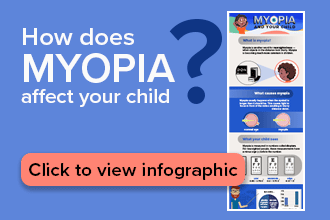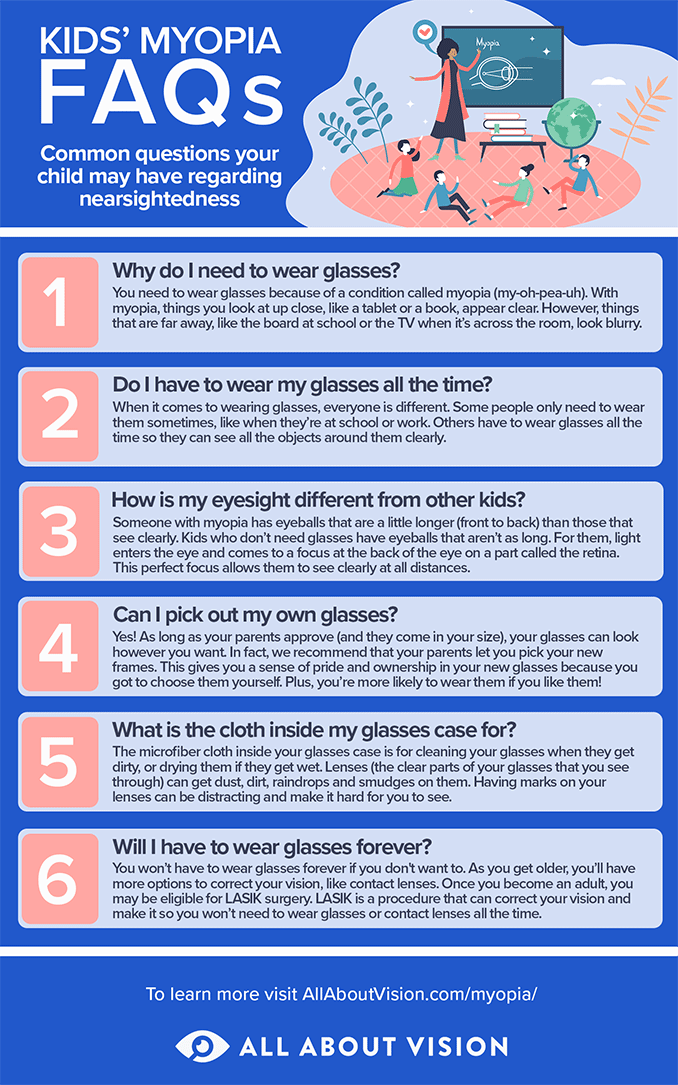How can I help my child understand myopia (nearsightedness)?

“Myopia” can seem like an overly technical word for a basic vision problem, more commonly called nearsightedness. Children may not understand the issue if you only tell them they have “myopia” or even “nearsightedness.” It’s important to actually explain what the impairment means.
Whether your child has myopia or you suspect that they have myopia, talking to them about it can be very helpful.
Explaining myopia to your child
First of all, what is myopia? Giving your child a simple explanation can make it feel less scary or confusing.
In simple terms, myopia is a vision problem that makes it difficult to see things that are far away. It can also be easily corrected with corrective lenses. These include either eyeglasses or contact lenses.
Why does myopia occur? If your eyeball is longer than normal, light doesn’t focus at the back of the eyeball as it should. This makes things far away look blurry. Myopia can also occur if the cornea (the clear front covering of the eye) is more curved than usual, which refracts or bends light too much.
Explain to your child that if either parent has myopia, it is more likely that they will have it, too. Reassure them that it is a common problem and that it is nothing to be afraid of.
Helping your child identify myopia
Myopia most commonly begins in children between the ages of 6 and 12. It can appear earlier or later than this age range, though. Myopia may also worsen as the eyes develop in early to late childhood. No matter the circumstances, it’s important to help be on the lookout for any changes in your child’s vision.
Young children who have myopia may struggle to see things clearly, but may not know how to verbalize what’s going on. Older children may also struggle to realize they have a vision problem or know how severe it is.
Look for signs such as these to help identify myopia in your child:
Excessive blinking
Holding objects, toys or books very close to the face
Complaints of blurry or strained vision
Trouble seeing the whiteboard at school
Be sure to listen to your child if they voice concerns about their vision. Let them know that it could be time for an eye exam to identify the problem.
SEE RELATED: 12 hidden signs your child may need glasses
Discussing an eye exam with your child
If there is a problem with your child’s vision, it should be checked. A comprehensive eye exam may seem like a scary experience for some kids. Discussing how the exam works with your child and eye doctor can be very helpful.
Eye exams usually include tests such as visual acuity tests. During this test, you look at an eye chart and read off the letters you see clearly. Your child’s eye doctor will also perform eye mobility and alignment tests.
More complex tests such as the glaucoma test are also done to make sure your child doesn’t have any underlying eye conditions. Each of these tests is important in a proper vision diagnosis.
If your child is nervous, you may want to stay in the room to comfort them throughout the exam. Younger children may also have a better experience with a parent in the room when their eyes are checked.
Encourage your child to ask questions during the exam if they feel comfortable doing so.
Understanding a myopia diagnosis
After an eye doctor completes a comprehensive eye exam, they will give your child a diagnosis and, if needed, a vision prescription. Myopia is usually corrected with prescription eyeglasses to help your child see clearly.
If your child is interested in contact lenses as well, discuss with their eye doctor. An additional exam is required for contacts, as the prescriptions for eyeglasses and contacts are different. Since contact lenses can be a big step for new glasses-wearers, it’s important not to pressure your child to get contacts right away.
Glasses can take a couple of weeks to get used to. If your kid notices additional symptoms after this time period, contact their eye doctor as soon as possible. Symptoms that should be reported include:
Blurry vision
Floating spots in their vision
Vision loss
The outlook of myopia
Talk with your child about their future with myopia. What can they expect from the vision impairment? The following points can give them reassurance for managing the condition.
Remind your child of all the unique options they have when it comes to eyeglass frame styles.
Myopia can worsen over time. They may need to get a new glasses prescription a few more times, but vision often stabilizes after age 20. That age has increased with all the digital activities people engage in today. So you might also discuss the importance of managing their screen time.
Even if your kid doesn’t feel that their vision has changed, it’s important to get a comprehensive eye exam once a year.
Eyeglasses are not the only option for myopia correction. Your child can get contact lenses or laser surgery later in life to correct the problem.
Those who have myopia may be at a greater risk of developing other eye problems, such as cataracts, retinal disease or glaucoma. So, remind them to take great care of their eye health.
No matter your child’s age, encourage them of the importance of eye and vision care. Many systemic conditions can be discovered during a comprehensive eye exam. If they have any additional questions, concerns, vision pain or problems, don’t hesitate to reach out to your eye care professional.
If your child still has questions about myopia, let them know that it is okay to ask their eye doctor. A friend who has the condition can also be helpful in explaining it to them.
READ NEXT: Common childhood vision problems
Myopia (nearsightedness) in children. Healthychildren.org, American Academy of Pediatrics. April 2021.
Nearsightedness (myopia). C.S. Mott Children’s Hospital, University of Michigan Health. August 2020.
Nearsightedness (myopia). Nemours KidsHealth. November 2020.
Myopia (nearsightedness). American Optometric Association. Accessed November 2021.
Page published on Tuesday, March 1, 2022
Medically reviewed on Tuesday, February 15, 2022








